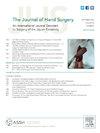Long-Term Patient-Reported Outcomes of the Medial Femoral Trochlea Osteochondral Free Flap for Proximal Scaphoid Reconstruction
IF 2.1
2区 医学
Q2 ORTHOPEDICS
引用次数: 0
Abstract
Purpose
The long-term outcomes of the medial femoral trochlea (MFT) osteochondral free flap for proximal pole scaphoid nonunion (SNU) reconstruction are unknown. The primary purpose of this study was to evaluate the upper and lower extremity patient-reported outcomes (PROs) of MFT for SNU reconstruction at a follow-up of >9 years.
Methods
Patients who underwent MFT for SNU reconstruction by the senior author >9 years ago were contacted to complete PRO questionnaires. Upper-extremity outcomes were reported with the Quick Disabilities of the Arm, Shoulder, and Hand (QuickDASH), Patient-Rated Wrist Evaluation (PRWE), and Patient-Reported Outcomes Measurement Information System Upper Extremity (PROMIS UE). Knee outcomes were reported with the International Knee Documentation scale, Knee Injury and Osteoarthritis Outcome Score, Kujala Anterior Knee Pain scale, and Western Ontario and McMaster Universities Osteoarthritis Index scales; scores were compared with normative data or established patient-acceptable symptom state thresholds to provide context. Long-term radiographic evaluation of scapholunate and radiolunate angles and revised carpal height ratio was also performed.
Results
Eleven of 12 patients completed PROs. The mean follow-up time was 10.2 years (range: 9.2–11.7). Bony union was achieved in all cases. The mean long-term QuickDASH was 4.5 ± 5.8, PRWE total 7.8 ± 9.1, and PROMIS UE 55.8 ± 6.1—all similar to normative population scores. The mean International Knee Documentation score was 91.2 ± 15.9 and Western Ontario and McMaster Universities Osteoarthritis Index score 96.0 ± 11.2; both comparable with normative data. The Kujala and Knee Injury and Osteoarthritis Outcome Scores reflected good postoperative knee function and minimal pain. None demonstrated radiographic evidence of radioscaphoid arthritis. There was no difference between preoperative and postoperative average scapholunate or radiolunate angle. Postoperative revised carpal height ratio (1.6) was similar to preoperative (1.5).
Conclusions
Medial femoral trochlea reconstruction for difficult, recalcitrant scaphoid proximal pole nonunion provides satisfactory, sustained long-term upper-extremity outcomes and stable radiographs with minimal donor-site morbidity.
Type of study/level of evidence
Therapeutic IV.
股骨内侧滑车骨软骨游离瓣用于舟状骨近端重建的长期疗效。
目的:股骨内侧滑车(MFT)骨软骨游离皮瓣修复近极舟状骨不连(SNU)的远期疗效尚不清楚。本研究的主要目的是评估MFT用于SNU重建的上肢和下肢患者报告的随访结果(pro)。方法:联系9年前接受MFT重建SNU的患者,填写PRO问卷。上肢结果报告了手臂、肩膀和手的快速残疾(QuickDASH),患者评定的手腕评估(PRWE)和患者报告的上肢结果测量信息系统(PROMIS UE)。膝关节结局采用国际膝关节文献量表、膝关节损伤和骨关节炎结局评分、Kujala膝关节前侧疼痛量表、西安大略大学和麦克马斯特大学骨关节炎指数量表进行报告;将得分与规范数据或建立的患者可接受的症状状态阈值进行比较,以提供背景。对舟月骨角和桡月骨角进行长期影像学评估,并对腕高比进行修正。结果:12例患者中有11例完成了PROs。平均随访时间为10.2年(9.2 ~ 11.7年)。所有病例均实现骨愈合。平均长期QuickDASH评分为4.5±5.8分,PRWE评分为7.8±9.1分,PROMIS评分为55.8±6.1分,均与标准人群评分相似。平均国际膝关节文献评分为91.2±15.9,西安大略和麦克马斯特大学骨关节炎指数评分为96.0±11.2;均可与规范数据比较。Kujala和膝关节损伤及骨关节炎结果评分反映术后膝关节功能良好,疼痛最小。没有放射学证据显示桡舟状骨关节炎。术前和术后平均舟月骨角和放射月骨角没有差异。术后修正腕高比(1.6)与术前相似(1.5)。结论:股骨内侧滑车重建术治疗困难、顽固性舟状骨近端骨不连提供了满意的、持续的长期上肢预后和稳定的x线片,供体部位发病率最小。研究类型/证据水平:治疗性IV。
本文章由计算机程序翻译,如有差异,请以英文原文为准。
求助全文
约1分钟内获得全文
求助全文
来源期刊
CiteScore
3.20
自引率
10.50%
发文量
402
审稿时长
12 weeks
期刊介绍:
The Journal of Hand Surgery publishes original, peer-reviewed articles related to the pathophysiology, diagnosis, and treatment of diseases and conditions of the upper extremity; these include both clinical and basic science studies, along with case reports. Special features include Review Articles (including Current Concepts and The Hand Surgery Landscape), Reviews of Books and Media, and Letters to the Editor.

 求助内容:
求助内容: 应助结果提醒方式:
应助结果提醒方式:


